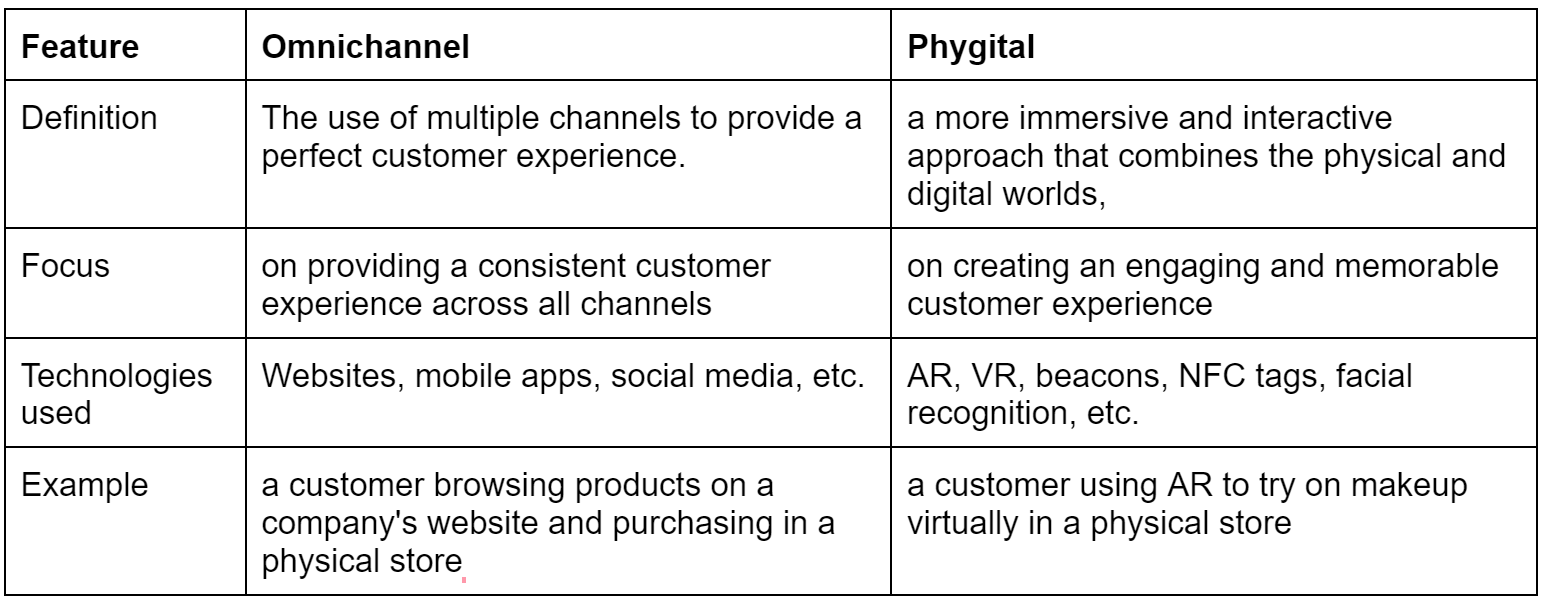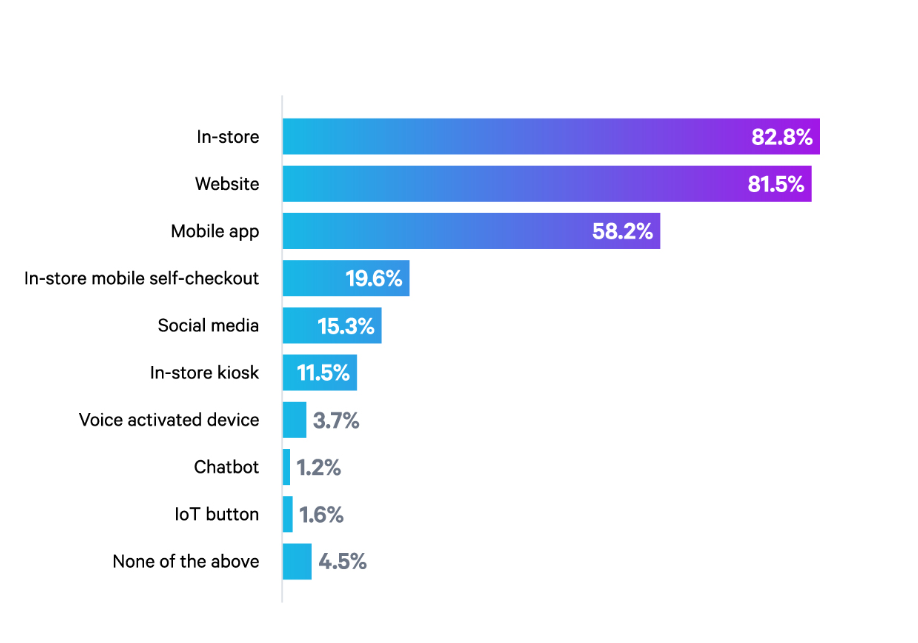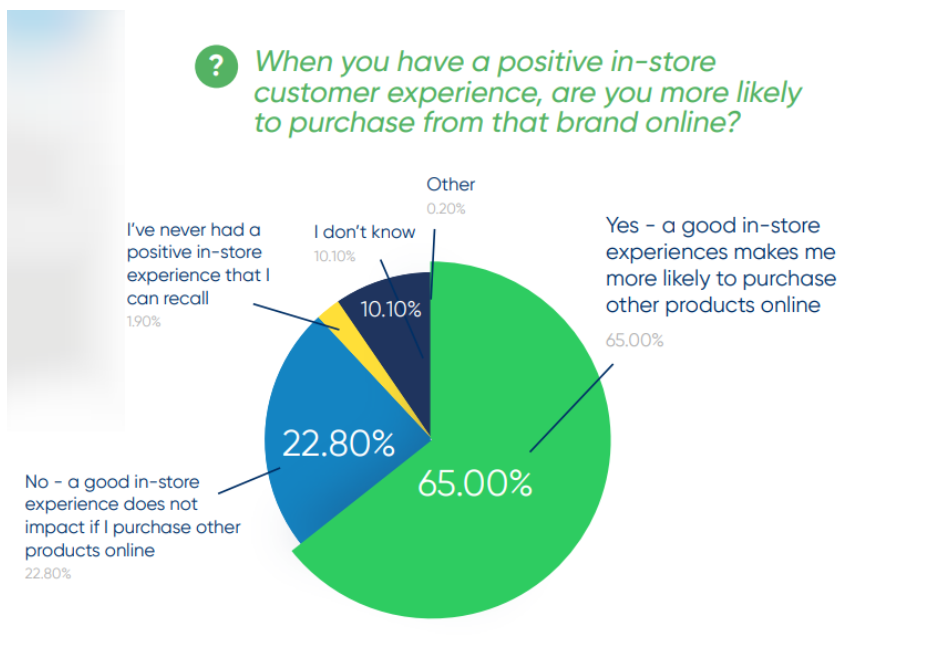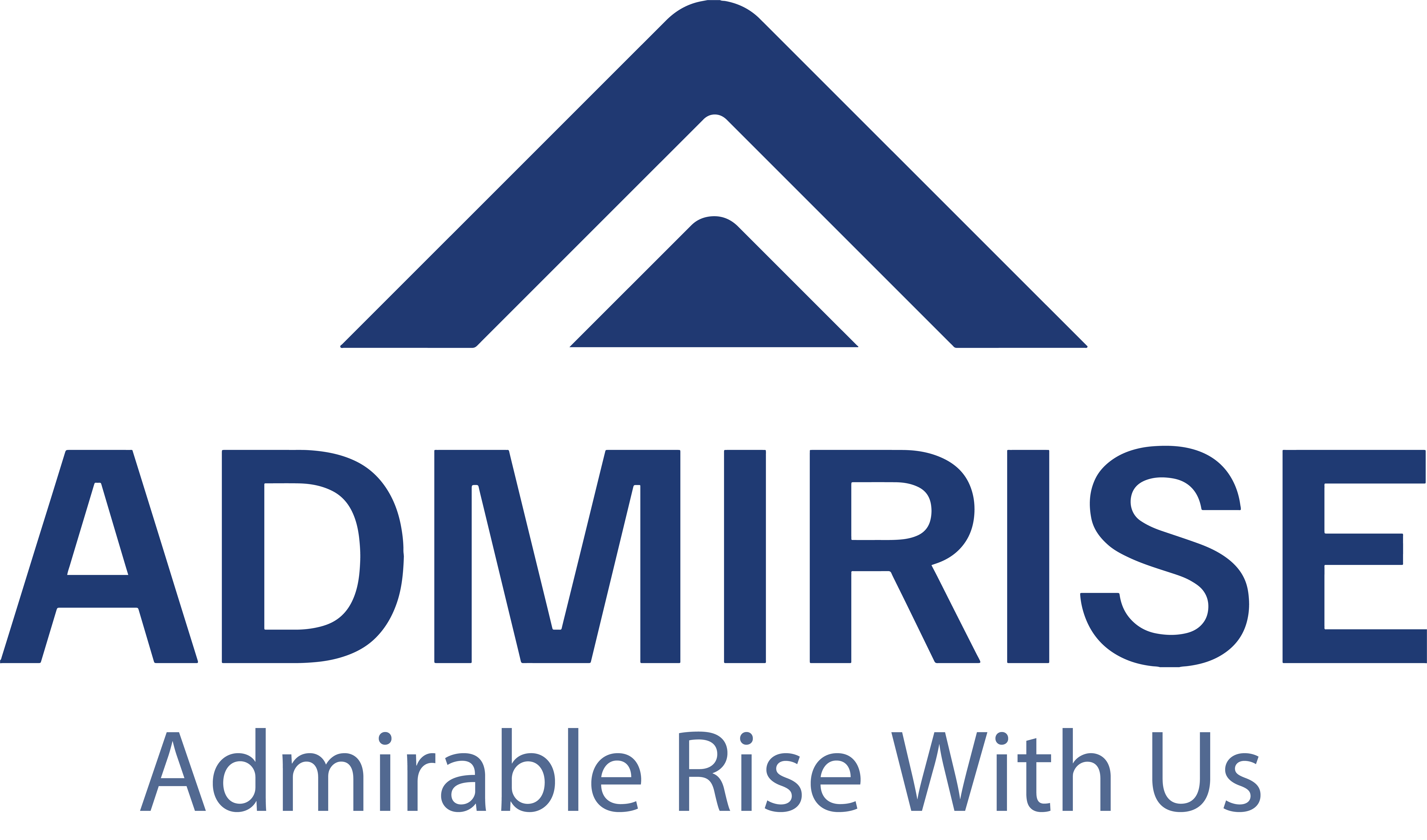
Phygital: Where The Physical and Digital Worlds are Together
Oct 19, 2023 in Online Marketing by Dilara Özcerit
"Phygital" is a testament to the seamless blend of the physical and digital realms, which keeps a holistic bridge between the physical and digital worlds. No longer are these two domains siloed or independent; instead, they intertwine and coexist in harmony, enriching our experiences and redefining how we interact with the world around us.
From augmented reality shopping experiences to smart infrastructures that respond to real-time data, the Phygital paradigm represents a future where boundaries are blurred and possibilities are endless.
Even today, we often encounter phygital experiences daily and will continue to encounter them gradually. This new term enables us to experience better services across different industries. For example, we can reach a restaurant’s menu by scanning its QR code. Once we reach the menu, we can easily see the food's pictures, videos, or details before ordering it. Join us on this journey as we explore a world where the tangible meets the virtual, creating synergies that were once the stuff of science fiction.
- What Does “Phygital” Mean?
- Phygital vs. Omnichannel: Understanding The Difference
- What is The Difference Between Phygital and Omnichannel?
- Why are Phygital Experiences More Relevant?
- Why are Phygital Experiences Gaining Popularity?
- Some Successful Phygital Campaigns
- 7 Benefits of Phygital Experiences
- Quantifying the Benefits of Phygital Marketing
- How Phygital is Reshaping Industries
- Phygital's Impact on Marketing
- Phygital in E-commerce
- What is Phygital Retailing?
- How is Phygital Affecting The E-commerce Landscape Relevant to E-commerce/Retail Business?
- What are The Challenges for The Phygital?
- The Future of Phygital Marketing
- How to Prepare Your Business for the Future
- Conclusion
What Does “Phygital” Mean?
Phygital combines two words to describe integrating “physical” and “digital” elements to create an enhanced experience.
In the age of technology and changing customer preferences, phygital is a perfect concept that merges the physical and digital worlds. This blending of two realms has reshaped the business and marketing world. Nowadays, businesses are concerned with their audiences and consumers and how they experience products and services.
Origins of the Term “Phygital”: The term phygital was coined in 2007 by Chris Weil, Co-CEO and Founder at Horizon Sports and Experiences. Its original context of marketing communications refers to building relationships with customers in both the physical and digital worlds.
Phygital vs. Omnichannel: Understanding The Difference
"Phygital" and "Omnichannel" often surface, evoking images of interconnectedness and seamless transitions. Both concepts are groundbreaking, offering unique approaches to bridging gaps and enhancing the consumer journey. However, while they may seem similar initially, understanding their nuances is essential. Each has its own distinct characteristics, goals, and strategies, impacting businesses and consumers in different ways.
What is The Difference Between Phygital and Omnichannel?
Both omnichannel and phygital aim to improve and enhance customer experiences. However, omnichannel focuses on delivering a consistent experience across various channels. Phygital, on the other hand, emphasizes the integration of physical and digital elements to create a unified experience. Technology enables consistent experiences in omnichannel, but it primarily focuses on engagement that is not technology-driven.
Here is the chart of the differences between phygital and omnichannel:

Why are Phygital Experiences More Relevant?
The changing consumer behavior has resulted in a fascinating combination of physical and digital experiences called "phygital." As we become more reliant on technology, the demand for immersive experiences is increasing. These phygital experiences merge the real-world touch and feel with the interactivity and convenience of the digital world and are transforming how consumers engage with brands. This fusion can redefine customer journeys, making them more personalized and enriching.
Why are Phygital Experiences Gaining Popularity?
The relevance of phygital in today's digital age is that it allows businesses to create more personalized and engaging customer experiences. By combining the physical and digital worlds, they appeal to multiple senses. Since it has increased customer satisfaction and sales, businesses have created more engaging experiences by combining the physical and digital worlds.
Here are some phygital experiences:
- Augmented Reality (AR): With AR technology, customers see products in their own environment before they buy them. For example, IKEA has an AR app that allows customers to see how furniture would look in their homes.
- Virtual Reality (VR): With VR technology, customers experience products and services in a virtual environment. For example, some car dealerships use VR to let customers test-drive cars.
- Beacons: Beacons are smart sensors that deliver personalized experiences to customers in physical stores. For example, a beacon could notify a customer's phone when they are near a product they will likely love.
- Phygital NFT: This combines physical and digital non-fungible tokens (NFTs). For example, the owner could pair a physical painting with an NFT that grants them access to exclusive content or experiences.
- QR Codes: QR codes can be scanned with a smartphone to access product information, reviews, or even to make a purchase. For example, retailers can provide more detailed information about the product using QR codes.
- Social Media Interaction: Social media is an excellent way for businesses to engage with customers and create phygital experiences. For example, Some businesses use social media for contests and to get customers to visit their physical stores.
- Smart Home Assistants: Home assistants combine physical hardware with digital intelligence. Devices like Amazon Echo or Apple Siri respond to voice commands. They merge the physical presence of the device with the digital capabilities.
- Phygital Art: This is the use of physical and digital elements to create art. For example, an artist could create a painting that can only be viewed through augmented reality glasses. Viewers interact with the painting in an impossible way with traditional paintings.
- Phygital Labs: Physical labs are where people can experiment with phygital technologies. For example, a museum could have a phygital lab where people can try on virtual clothing or create their own NFTs.
Some Successful Phygital Campaigns
- Pokemon Go: Pokemon Go is an augmented reality mobile game and a good example of gamification and phygital experience. The game unifies both the real world and the digital world in itself. Pokemon Go caught 5 new world records in its release year. Some of them are the most revenue grossed by a mobile game in its first month, the Most downloaded mobile game in its first month, and the Fastest time to gross $100 million by a mobile game. (Swatman, 2016)
- Sephora Virtual Artist: Sephora Virtual Artist is an AR app that allows customers to try on makeup virtually. Customers can use the app to see how products would look on their faces. Since the app launched, Sephora Virtual Artist has had over 8.5 million visits, according to the company's statistics. (Rayome, 2018)
- IKEA Place: IKEA Place is an AR app that allows customers to see how furniture would look in their homes. Customers can use the app to scan their rooms and see how furniture would fit.
7 Benefits of Phygital Experiences
Enhanced Engagement: Phygital experiences capture customers' attention through interactive elements that appeal to multiple senses. For example, an augmented reality retail store can engage customers with the physical space and the digital game.
Memorable Experiences: Combining physical and digital elements creates unique and memorable moments. An interactive museum exhibit incorporating virtual reality can leave a lasting impression on visitors.
Personalization: Phygital experiences allow for unique interactions. A clothing store's virtual fitting room can suggest items based on a customer's preferences and previous purchases.
Convenience: Customers can enjoy the convenience of digital interactions while benefiting from physical spaces. For example, a mobile app guiding users through a zoo can provide information and interactive features as they explore.
Increased Sales: Businesses can leverage phygital experiences to influence purchasing decisions. An interactive makeup tutorial within a cosmetics store can encourage customers to try new products, potentially leading to more sales.
Data Collection: Phygital interactions generate data that businesses can use for insights. A drink company can gather feedback and preferences from individuals at a virtual taste-testing event. This information can assist the company in making decisions for its plans.
Reduced Costs: Phygital can help businesses reduce costs by improving efficiency and productivity. For example, phygital can be used to track inventory levels and prevent stockouts.
Quantifying the Benefits of Phygital Marketing
A 2019 State of E-commerce study found that many customers prefer hybrid experiences that combine online and physical channels. Customers still want to engage with people when they are shopping. Here are the answers to the question, “In the last 12 months, have you purchased products or services from any of the below channels?” (Suau, 2019)
According to the study, customers who use more channels are more valuable than those who use only one channel. (Suau, 2019)

Another study found that customers with a good in-store experience are likelier to buy things. (Raydiant, 2021)

In other words, customers want to be able to interact with brands and businesses in a variety of ways. They may want to start their shopping journey online and visit a physical store to try clothes or see a product in person.
How Phygital is Reshaping Industries
In today's business world, phygital is transforming industries and trends worldwide. From marketing to retail and beyond, the integration of two realms is giving rise to innovative and different strategies for business operations.
Phygital's Impact on Marketing
Enhanced Customer Engagement: Phygital experiences can help brands engage customers at multiple touchpoints. Thereby, they can easily reach their target audience. For example, a brand could use augmented reality to allow customers to interact with products digitally before purchasing.
Digitally Enhanced Shopping: Retailers incorporate digital elements into their stores to enhance the in-store experience. This could include interactive displays, virtual fitting rooms, or QR code-based product information.
Augmented Showrooms: Retailers use augmented reality to let customers see products in their preferred settings before buying.
Virtual Try-ons: Retailers use virtual try-on tech to let customers try on clothes or makeup before buying.
The impact of phygital is not limited to marketing and retail. It is also being used in other industries, such as:
- Healthcare: Surgeons can see 3D images of their patients’ bodies during surgery using AR.
- Education: Phygital education platforms blend physical classrooms with online resources, creating a hybrid learning experience that caters to diverse learning styles.
- Entertainment: Theme parks and museums are incorporating augmented reality elements to enhance visitor experiences and provide interactive learning opportunities.
Phygital in E-commerce
The rise of phygital experiences has begun reshaping the e-commerce landscape profoundly. As consumers increasingly seek immersive shopping experiences seamlessly blending the physical and digital dimensions, e-commerce platforms and managements must innovate. By integrating phygital elements, online retailers are enhancing the shopping journey and setting new benchmarks for customer engagement and satisfaction.
What is Phygital Retailing?
Phygital retailing is the merging of the physical and digital worlds in retail. Companies can now provide their customers with a thorough and flawless shopping experience.
Virtual fitting rooms, AR, beacons, click and collect (customers order products online and purchase them in-store), and shipping from the store are invaluable e-commerce practices.
Phygital retailing helps e-commerce businesses improve customer satisfaction, increase sales, and reduce costs. For customers, it offers a more unique and personalized shopping experience.
As technology continues to evolve, we can expect to see even more innovative ways to use phygital retailing.
Some of the technologies that use phygital retailing:
- Virtual Reality (VR): Virtual reality (VR) enables the creation of immersive experiences that allow customers to interact with products realistically.
- Mixed Reality (MR): Mixed reality combines the real and virtual worlds. It lets people see products in their surroundings and interact with them using digital elements.
- 3D Printing: 3D printing can create customized products tailored to customers' needs.
- Blockchain: Blockchain enables tracking the provenance of products and ensures that customers receive authentic products.
How is Phygital Affecting The E-commerce Landscape Relevant to E-commerce/Retail Business?
Phygital is continuously affecting the e-commerce landscape in a number of ways. This is relevant to e-commerce/retail businesses as it allows them to create more immersive online and offline experiences for customers. Fashion and personal training are one of them.
Phygital Fashion:
- Virtual Fitting Rooms: Allow customers to try on clothes virtually before they buy them. This can be done using augmented reality (AR) or virtual reality (VR).
- 3D Printing: This allows customers to customize their clothing and accessories.
- Personalized Styling: Uses data about a customer's style preferences to recommend products they like.
Phygital Training:
- Virtual Reality (VR) Training: Allows employees to learn new skills in a safe and realistic environment.
- Augmented Reality (AR) Training: Allows employees to see instructions and guidance overlaid on the real world.
- Mixed reality (MR) Training: Combines the real and virtual worlds, allowing employees to interact with objects realistically.
What are The Challenges for The Phygital?
- Technical Barriers: Phygital experiences often require advanced technologies, such as augmented reality (AR) and virtual reality (VR). These technologies are somehow difficult to implement.
- Phygital Strategies: Phygital strategies can be complex and require a deep understanding of the physical and digital worlds. It can be challenging to integrate these two worlds flawlessly.
- Customer Acceptance: Some customers may be hesitant to embrace phygital experiences. They may not be ready to be involved in new technologies.
- Cost: Phygital experiences can be expensive to implement and maintain.
Despite some challenges, phygital has the potential to be a powerful tool for businesses. Companies can create innovative and engaging experiences that improve customer satisfaction by overcoming such difficulties.
The Future of Phygital Marketing
The future of phygital marketing is exciting. Technology will keep advancing, and businesses can use phygital marketing to create more creative and captivating customer experiences. Companies will need to overcome some challenges to succeed with phygital marketing. Some trends expected to shape the future of phygital marketing are AI's rise, the metaverse's growth, and the increasing importance of data.
How to Prepare Your Business for the Future
In an evolving world, companies should evolve. To prepare your business for the future in a phygital world, you need to:
1. Understand your customers' needs. What are they looking for in a phygital experience? What are their main points? Once you understand their needs, you can start developing phygital solutions and phygital strategies for them.
2. Invest in technology. The phygital world is powered by technology. You need to invest in the right technologies to create the phygital experiences your customers want.
3. Embrace change. The world is changing and evolving, and so is the phygital world. You need to be willing to embrace change and adapt your business accordingly. This may sometimes mean changing your business model, marketing strategy, or products and services.
4. Collaborate with others. To create successful phygital experiences, you need to collaborate with others. You could learn new ideas and information from your collaborators.
Conclusion
In conclusion, the phygital world is dynamic, evolving each day. Phygital is more than just a merging of technology and reality. Phygital is a powerful and influential tool businesses can use for better outcomes.
Phygital is not just about shopping, but it's about creating new ways to interact, learn, and engage. Phygital experiences can open doors to new opportunities in education, entertainment, and social connection.
Embrace phygital and be a part of this revolutionary wave. Start learning more about phygital and how it can benefit your business. Contact us to discuss how we can help you create a phygital experience for your customers.
References
Swatman, R. (2016, August 10). Pokémon Go catches five new world records.
https://www.guinnessworldrecords.com/news/2016/8/pokemon-go-catches-five-world-records-439327
Rayome A. (2018, February 15). How Sephora is leveraging AR and AI to transform retail and help customers buy cosmetics.
https://www.techrepublic.com/article/how-sephora-is-leveraging-ar-and-ai-to-transform-retail-and-help-customers-buy-cosmetics/#:~:text=Since%20launching%20on%20the%20app,feature%2C%20according%20to%20the%20company.
Susau. (2019, January 11). 2019 State of eCommerce Report: Brick and mortar isn't dead, boring commerce experiences are.
https://www.elasticpath.com/blog/2019-state-of-xcommerce-report
Raydiant. (2021). State of Consumer Behavior.
https://f.hubspotusercontent30.net/hubfs/6899838/eBooks/ebook_stateofconsumer_experience_report.pdf







